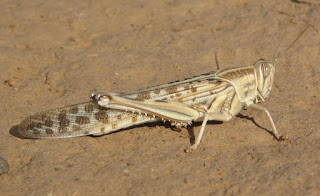Another deadly threat confronts the world
 |
| A desert locust |
That veritable threat is from
desert locusts, swarms of them in Ethiopia, Kenya and Somalia, already
unprecedented in their size and destructive potential, and yet could swell
exponentially and spill over into more countries in East Africa if efforts to
deal with them are not massively scaled up across the region, the Food and Agricultural
Organisation has warned gravely.
"This has become a situation
of international dimensions that threatens the food security of the entire
subregion. FAO is activating fast-track mechanisms that will allow us to move
swiftly to support governments in mounting a collective campaign to deal with
this crisis," said FAO Director-General QU Dongyu.
"Authorities in the region
have already jump-started control activities, but in view of the scale and
urgency of the threat, additional financial backing from the international
donor community is needed so they can access the tools and resources required
to get the job done. FAO stands ready to leverage our expertise and facilitate
a coordinated regional response," he said.
Recent weather in East Africa has
created conditions that favour rapid locust reproduction. Left unchecked, the
numbers of crop-devouring insects there could grow 500 times by June.
Such swarms - potentially
containing hundreds of millions of individual desert locusts -- can move 150
kilometres a day, devastating rural livelihoods in their relentless drive to
eat and reproduce. A desert locust devours its own weight in food per day -
about two grams.
Swarms continue to pour into
Kenya from Ethiopia and Somalia and are rapidly spreading to the centre of the
country.
In Ethiopia, they are moving
steadily south towards the Rift Valley, the country's breadbasket.
Ethiopia and Somalia have not
seen swarms of this scale in 25 years, while Kenya has not faced a threat of
this magnitude in 70 years.
South Sudan and Uganda are not
currently affected, but are at risk.
The FAO is providing forecasts,
early warning and alerts on the timing, scale and location of invasions and
breeding.
The speed of the pest's spread
and the size of the infestations are so far beyond the norm that they have
stretched the capacities of local and national authorities to the limit.
Given the scale of the current
swarms, aerial control is the only effective means to reduce the locust
numbers.
"Alongside pest control
activities, our response must include efforts to restore people's livelihoods. Communities
in Eastern Africa have already been impacted by extended droughts which have
eroded their capacities to grow food and make a living. We need to help them
get back on their feet once the locusts are gone," Dongyu added.
At this stage and on basis of
conservative estimates, FAO seeks $70m to urgently support both pest control
and livelihood protection operations in the three most affected countries.
The problem however with the
locusts is that they are not in Africa alone.
Southwest Asia and the Red Sea
area are also affected.
In India, Iran and Pakistan,
numerous swarms have been present since June 2019 and have been breeding. Some
of them have migrated to southern Iran where recent heavy rains allowed them to
lay eggs that could turn into swarms in spring 2020.
Egypt, Eritrea, Saudi Arabia,
Sudan and Yemen are also seeing substantial breeding activity that could see
locust bands expand into swarms in the coming months.
FAO is monitoring all situations
closely, and is actively engaging with all countries facing desert locust
threats to support their response activities.
God save the world.



Comments
Post a Comment